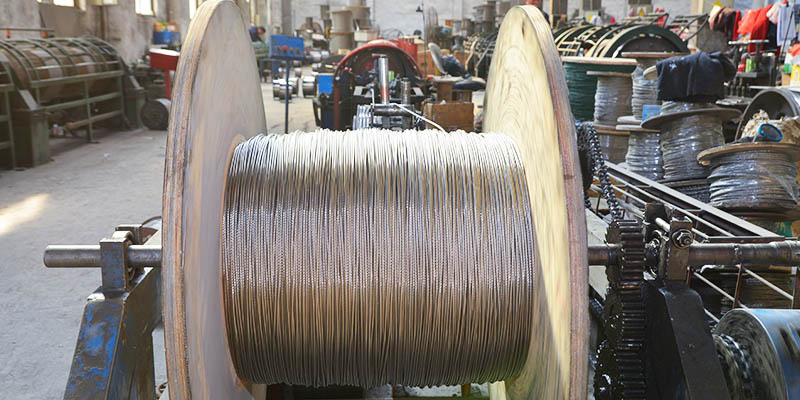1×7 Stainless Steel Wire Rope Product Introduction Overview: The 1×7 stainless steel wire rope is a high-quality, durable, and versatile wire rope constructed from a single strand of seven individual ...
See DetailsIn modern manufacturing and engineering construction, stainless steel nuts, as one of the key fasteners, undertake multiple functions such as structural connection, load distribution and corrosion resistance. Despite its small size, the performance stability and reliability of stainless steel nuts in various equipment, building structures and even precision instruments directly affect the safety and durability of the overall system.
High-performance materials create excellent nut quality
The most fundamental reason why stainless steel nuts are widely used is the excellent performance of their materials. Stainless steel is an alloy steel with a high chromium content. It has good oxidation resistance and corrosion resistance and remains stable in variable environments such as humidity, acid, alkali, and salt spray. This natural corrosion resistance makes stainless steel nuts particularly suitable for industries such as marine, chemical, food processing, and medical equipment that have extremely high requirements for material resistance.
The common stainless steel materials on the market currently include austenitic 304 and 316 series, ferritic 430 series, and a few duplex stainless steels for special purposes. Among them, austenitic stainless steel occupies a dominant position in nut production due to its good formability, weldability and corrosion resistance.
Precision process ensures fastening reliability
The manufacturing process of stainless steel nuts is a dual guarantee of precision and strength. Its forming methods are mainly divided into cold heading and hot forging. The former is suitable for small specifications and large-scale production, while the latter is suitable for high-strength and large-size customization. After forming, the nuts need to go through multiple steps such as tapping, annealing, cleaning, and passivation to ensure that their thread accuracy and surface cleanliness meet industrial requirements.

Passivation treatment is one of the key steps to improve the corrosion resistance of stainless steel nuts. By immersing the nuts in a specific acidic solution, a dense and stable chromium oxide film is formed on the surface, which can significantly improve its service life in harsh environments. For areas with special needs, electrolytic polishing, sandblasting or black oxidation are also used to functionally treat the surface of the nuts to further expand their application scenarios.
Diversified applications drive the continuous expansion of the market
In modern industrial systems, stainless steel nuts are almost everywhere. Whether it is heavy engineering projects such as bridges, high-speed railways, and ships, or precision equipment systems such as power, communications, and medical care, stainless steel nuts play an irreplaceable role. Its excellent mechanical properties and environmental adaptability enable it to cope with multiple challenges such as different loads, temperature changes and external corrosion.
Especially in the field of new energy and environmental protection equipment manufacturing, the demand for stainless steel nuts is showing a rapid growth trend. On the one hand, this is due to its advantages in environmental protection properties such as low carbon and recyclability. On the other hand, it is also because the stainless steel material itself conforms to the concept of green manufacturing and can meet the national policy orientation for energy conservation and consumption reduction.
The development path of both standardization and non-standard customization
At present, the product types and models of stainless steel nuts have become diversified. Standard parts are still the mainstream in the domestic and foreign markets, but with the rise of high-end equipment manufacturing and special engineering projects, the demand for non-standard customization is growing. This has promoted the upgrading of nut companies in R&D, design and personalized service capabilities.
For non-standard products, customers pay more attention to the matching degree of performance indicators such as size, strength grade, thread accuracy and surface treatment. Under this trend, companies with high-precision manufacturing capabilities and flexible production lines have gradually stood out in the market and won the trust of more high-end customers.

Future development: high performance and multi-function go hand in hand
Looking to the future, the technical development of stainless steel nuts will focus more on the integration of high strength, light weight and multi-function. On the one hand, in high-end fields such as aerospace and military industry, more stringent requirements are put forward for the strength and stability of fasteners; on the other hand, the development of intelligent equipment has also prompted fasteners to gradually integrate more sensing, connection and signal transmission functions to form a new generation of "intelligent nut" system.
The stability, safety and durability of stainless steel nuts are the indispensable cornerstones of the entire system. With the continuous advancement of manufacturing technology and the continuous expansion of application needs, stainless steel nuts will continue to play a vital role in the process of industrial modernization. From precision structures to grand projects, this small fastener is silently supporting the industrial backbone of the entire era.
